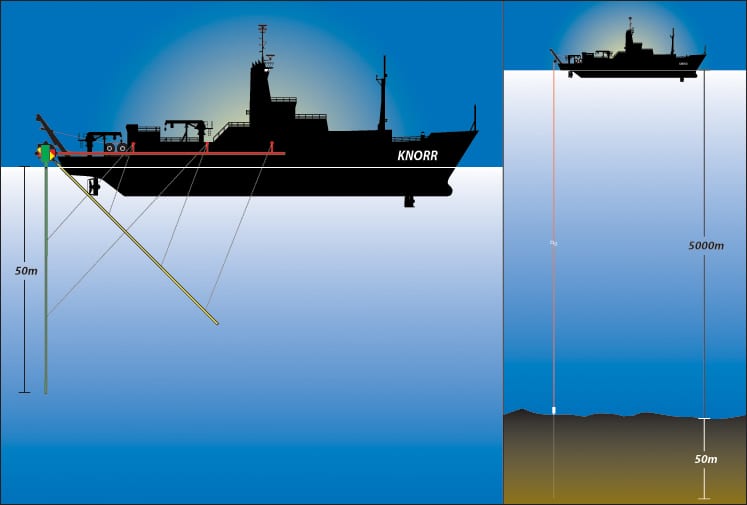New Piston Corer Will Give U.S. Scientists their Deepest Reach into Sea Floor
December 8, 2003
The longest piston coring system in United States will be built at the Woods Hole Oceanographic Institution, allowing scientists to sample ancient sediment on the sea floor that is potentially rich with information about ocean and climate history.
The corer will penetrate up to150 feet into the ocean bottom and weigh about 25,000 pounds, said William Curry, a climate scientist and head of the Ocean and Climate Change Institute at WHOI. The new big coring system is nearly twice as long and four times as heavy as existing systems in the U. S. research fleet.
Curry and co-investigators James Broda, an engineer in the WHOI Geology & Geophysics Department, and Nicklas G. Pisias of the College Oceanic & Atmospheric Sciences at Oregon State University, have received $4.5 million from the National Science Foundation (NSF) to develop the new piston corer and outfit a research vessel for its use. Construction on the piston corer will begin this winter and is expected to be complete for testing and use by 2006.
“We needed to obtain better and longer sediment records,” Curry said to explain why he wanted the corer developed for use in oceans worldwide. The new piston corer “is going to greatly improve the quality of the cores we recover for the U.S. community.” added Broda, who has worked designing and engineering corers at WHOI since 1980.
Recovering sediment cores allows scientists to see the presence or absence of specific fossils in the mud that may indicate climate patterns at times in the past, such as during the ice ages, Curry said. Scientists can then use this information to improve understanding of the climate system and predict patterns and events in the future.
The piston corer will be among the longest and heaviest of its type in the world, said Broda, who identified a corer of similar length and weight used by French oceanographers as a successful coring system in use today.
The new WHOI piston corer will act like a giant probe, plunging into the seafloor and collecting mud in its hollow open pipe. A seal on the bottom of the device will retain the sediment sample during retrieval, capturing for scientists a time capsule that, in some cases, can span the past hundreds of thousands and even millions of years.
Engineers at WHOI will design and build the corer of stainless and alloyed steels, using lead as ballast. It will be assembled from 10-foot long, modular sections of pipe, allowing engineers and scientists to adjust the length of the corer. Several outside consulting companies will be involved in the development of new hydraulic equipment to help handle the heavy corer at sea. While the core is developed, one of WHOI’s research vessels, the 279-foot Knorr, will be fitted with specialized handling gear, a new winch, and an A-frame to safely support and launch the corer. A custom braided, synthetic fiber rope capable of lifting up to 350,000 pounds will also be developed to support the coring operations. Knorr will serve as a prototype for the system, which is designed to be portable.
The funding for the design concept for the piston corer was provided by two foundations, the Grayce B. Kerr Fund, Inc. and The Cecil and Ida Green Foundation.
Woods Hole Oceanographic Institution is a private, independent marine research and engineering, and higher education organization located in Falmouth, MA. Its primary mission is to understand the oceans and their interaction with the Earth as a whole, and to communicate a basic understanding of the ocean’s role in the changing global environment. Established in 1930 on a recommendation from the National Academy of Sciences, the Institution is organized into five departments, interdisciplinary institutes and a marine policy center, and conducts a joint graduate education program with the Massachusetts Institute of Technology.

